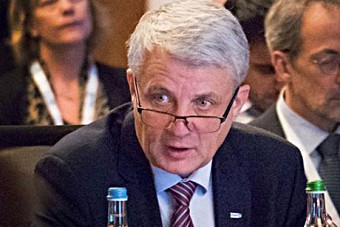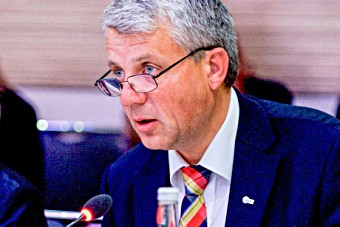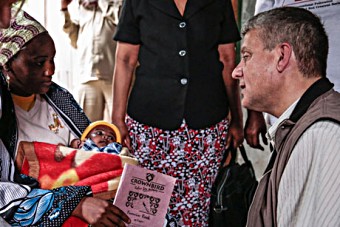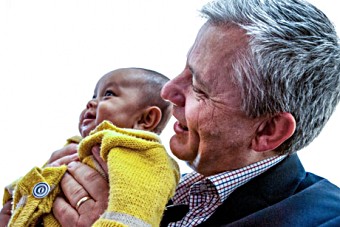'Deliver, deliver, deliver' – Dagfinn Høybråten reflects on five years as Gavi Board Chair

Dagfinn Høybråten addresses the Gavi Board, Geneva Gavi/2015/Sam Phillips
How would you describe your five years as Gavi Board Chair?
In my over 30 years as a public servant, including spells as a Minister, a Member of Parliament and leadership roles in public administration, I have had the honour of working for several humanitarian causes. However, looking back, I can honestly say that I have never been involved in a single greater mission than Gavi’s: to save children’s lives with vaccines. What can be more important? Our common achievements at Gavi will always stand out as a highlight in my public service.
Over the last five years, Gavi has experienced unprecedented growth both in its operations and its impact. The collaboration between our partners is closer and stronger than ever and, as awareness of our cause has grown, we have witnessed a growing base of donors ready to step up and take responsibility for supporting our work.
It has been tremendously rewarding to work with such an inspiring group of Board Directors. Gavi’s partners are engaged and deeply passionate about the Alliance’s work, bringing a unique mix of experience and knowledge from both the private and the public sector. Likewise it has been a joy to work with highly professional and dedicated people at Gavi’s headquarters in Geneva and Washington, DC.
What was your goal when you were appointed Chair and have you achieved it?

Dagfinn Høybråten speaking at Gavi's London pledging event in 2011.
At the time I took over as Chair, the Vaccine Alliance had a shortfall of US$ 3.7 billion, and we had no Chief Executive. My immediate priority was to help secure funding and to get a good CEO in place.
I will never forget the electric atmosphere of Gavi’s first replenishment conference in London, June 2011. When the final numbers were shared with me I had to pinch myself: was this really happening? The pledges amounted to US$ 4.3 billion, US$ 600 million more than our request. And remember: this took place in a very challenging financial environment. The success was a result of many contributions, but we would never have achieved success without the extraordinary and crucial leadership of Prime Minister David Cameron of the UK, Prime Minister Jens Stoltenberg of Norway and Bill Gates.
By the time of the London replenishment conference we had already hired a world class CEO, the former head and founder of IAVI (the International Aids Vaccine Initiative): Dr Seth Berkley. Seth is a visionary leader with great knowledge and experience in the field of global health, he is a passionate advocate for Gavi and vaccines, and he is very ambitious on what Gavi and its partner organisations can achieve together.
Since the replenishment in June 2011, my focus as Board Chair can be described with three words: ‘deliver, deliver and deliver’. Our partners put great trust in Gavi at the London conference, but they also gave us great responsibility. I have tried to constantly remind the Board and myself that we need to stay focused and make sure we deliver on our promises. Many children’s lives depend on the Vaccine Alliance. Results are also the best basis for being entrusted with even greater tasks in the future.
What is the biggest change you have seen at Gavi since you took over as Chair?
A lot has changed since I took over as Chair in 2011, and even more since 2006 when I first became a Board member.
Collaboration between implementing partners like WHO and UNICEF is closer and more efficient. Governance structures are stronger. For example, the Executive Committee has a more clearly defined role within the organisation and we have established clearer rules to handle potential conflict of interest. Given the tremendous expansion of Gavi operations , the Board has worked with the Secretariat to strengthen risk management. The process of applying for Gavi support is now better aligned to the needs of implementing countries, while the countries themselves have stepped up their efforts, increasing both their co-financing of vaccines and their overall investments in immunisation.
However, even if the organisation has matured and its policies and structures are stronger, the characteristics that first attracted me to Gavi are unchanged : the Vaccine Alliance is still an innovative, lean and effective organisation with a sharp focus on saving children’s lives and protecting people’s health with vaccines. And Gavi’s spirit of collaboration remains central to our approach.
What is your favourite memory from this period?

Speaking with parents in Tanzania, 2012.
The first Gavi replenishment in London in 2011 is definitely a memory I will always cherish. Another special Gavi moment took place earlier this year at our Pledging Conference in Berlin. Hosted by German Chancellor Angela Merkel, the Vaccine Alliance managed to mobilise US$ 7.5 billion, giving Gavi-supported countries sufficient resources to immunise a further 300 million children and save 5 to 6 million lives from 2016-2020.
However, my absolute favourite Gavi memories remain the faces behind the numbers: the parents and children who receive Gavi vaccines and the health workers who deliver them. My first ever Gavi field visit took place in Malawi. We followed the cold chain from the central store in the capital Lilongwe all the way through hospitals, district clinics to a village where vaccination took place in the shade of a huge tree. The mothers were singing as we arrived. I asked the local community leader to speak and took the opportunity to explain the role of our Alliance in protecting their children against deadly diseases. Spontaneously, some 250 mothers responded with a song of gratitude. That was my first Gavi moment.
I treasure another memory from Tanzania. I was asked to address a group of parents in Shambarai village, some of whom had walked more than 20km to have their children vaccinated. I will never forget the look on parents’ faces when I explained that Tanzania that very week had introduced new vaccines against two of the country’s biggest child killers – pneumonia and severe diarrhoea. The mums and dads knew instinctively and sometimes from painful experience that these diseases too often claim the lives of children before they reach their fifth birthdays.
What are the main achievements of Gavi during the past 5-year period?
First and foremost, our progress in helping developing countries introduce the five-in-one pentavalent vaccine as well as the pneumococcal and rotavirus vaccines has been remarkable. Today all 73 Gavi countries have introduced pentavalent vaccine. Pneumococcal and rotavirus vaccines are part of routine immunisation in more than 50 and 35 countries respectively. Since 2011, the average price of this vaccine package has dropped 40%. There are more vaccine suppliers and better supply security.
In the same period, Gavi also took some hard, but extremely important decisions: first, the addition of the human papillomavirus vaccine against cervical cancer to our portfolio; second, a commitment to help introduce the inactivated polio vaccine (IPV) in all Gavi countries as a part of the renewed global effort to eradicate polio. We said that we would do this in addition to the already ambitious programmes to which we were committed -- but with additional resources. And we have been true to our word.
I am also proud that the Vaccine Alliance acted rapidly and resolutely when it became clear that we could play a role in the Ebola response -- both in the rebuilding of the health system and in ensuring the development and procurement of a vaccine against Ebola to prevent future outbreaks.
On the governance side I am pleased that we have moved from a middle of the roader to world class on the Aid Transparency Index. That reflects good stewardship. I have also been single-minded in enforcing Gavi’s gender policy and am pleased to leave the Board with a good gender balance.
What are the major challenges that Gavi faces in the next 5-year period?

Cambodia November 2013, Dagfinn met families attending a pentavalent vaccination session introduced with the support of Gavi and its partners.
Within developing countries, the children who die before the age of five and who miss out on life-saving vaccines are often those living in the hardest-to-reach areas and in the poorest households. Gavi’s main focus and biggest challenge over the next five years must be helping countries increase coverage and equity, ensuring these children are also protected with vaccines.
We also face a crucial test of the sustainability of the “Gavi-model” as several countries transition out of Gavi-support toward full self-financing of their routine immunisation programmes. Gavi must ensure that these countries are adequately supported and prepared throughout this challenging phase.
Gavi also has a lead role in keeping immunisation high on the global health agenda. We have made some progress, but we know from recent history that without a sustained focus, vaccine coverage can all too easily decrease, and diseases and death increase. This is why Gavi is asking for a vaccine indicator to help measure progress against the new Global Goal for health.
Gavi was one of the first innovative partnerships in the field of global health. How has the Alliance’s structure helped it to achieve results?
By drawing on the best and brightest from both the private and public sector, we have set new standards in multilateral cooperation, especially when with our governance style. There are inevitable moments of tension, but, most of the time, this brings a constructive dynamism to Gavi discussions.
Our innovative finance solutions, such as IFFIm, would probably never have happened without the marriage of public and private sector experience and expertise. The potential role of private sector solutions to address challenges in coverage and equity, especially supply chain management, is also a promising aspect of future Gavi partnerships.
